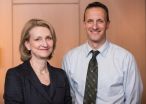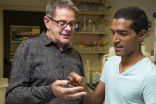(Press-News.org) An innovative cell therapy against a highly aggressive form of acute lymphoblastic leukemia (ALL) continues to show highly promising results in children treated in a pilot study. Ninety-two percent of the 39 children receiving bioengineered T cells had no evidence of cancer at one month after treatment, with this complete response persisting in some cases for more than two years. The personalized cell therapy reprograms a patient's immune system and offers the potential of long-term success.
"As we continue to follow children in this study, we see exciting results for patients who have exhausted their other treatment options," said study leader Stephan A. Grupp, M.D., Ph.D., a pediatric oncologist at The Children's Hospital of Philadelphia and a Professor of Pediatrics at the Perelman School of Medicine of the University of Pennsylvania. Grupp described outcomes and follow-up results of this pilot clinical trial for pediatric patients with ALL in a press program today at the annual meeting of the American Society of Hematology (ASH) in San Francisco.
Grupp, first author Shannon Maude, M.D., Ph.D., a pediatric oncologist at CHOP and Assistant Professor of Pediatrics at the Perelman School of Medicine of the University of Pennsylvania, and colleagues reported today that of the 39 children treated, 36 (92%) had complete responses one month after treatment. Of those 36 patients, 25 (69%) remained in remission at a median follow-up of 6 months after treatment. There were 10 relapses among the 36 patients with complete responses; 5 of the relapsed patients died.
Grupp is an ongoing collaborator with colleagues at Penn Medicine, led by Carl H. June, M.D., who offer this personalized cell therapy as a treatment for adult patients with other types of cancer.
ALL is the most common childhood cancer and the most common childhood leukemia.
All the patients had high-risk ALL that recurred after initial treatment or resisted that treatment from the start. Patients received bioengineered "hunter" T cells called CTL019 cells.
The first child to undergo this therapy, 9-year-old Emily Whitehead, remains cancer-free since her T cell treatment in April 2012, and continues to enjoy normal childhood activities like going to school and playing with her dog, Lucy. Emily has appeared prominently in news stories since her doctors announced dramatic findings during the December 2012 ASH meeting.
A relatively new approach in cancer treatment, this type of immunotherapy modifies T cells, the workhorses of the body's immune system, to attack B cells, other immune cells that become cancerous in specific leukemias such as ALL. Bioengineered T cells, called CTL019 cells, function as cancer hunters, killing the leukemia cells that normally evade regular T cell surveillance. Researchers first extract a patient's own T cells. They then use bioengineering techniques to reprogram each patient's T cells into chimeric antigen receptor cells--the CTL019 cells--custom-designed to bind to a protein called CD19 that exists only on the surface of B cells. After being returned to the patient's body, the CTL019 cells proliferate and then eliminate B cells. Moreover, they persist in the circulation, helping to guard against the cancer's recurrence.
As the CTL019 cells potently attack leukemia cells, they also stimulate an unwanted, toxic immune response called cytokine release syndrome in patients. The care team successfully counteracted these side effects with an immunomodulating drug that had never been used for that purpose before, an approach which now has been adopted widely by cell therapy groups. In addition, because the CTL019 therapy eliminates healthy B cells along with cancerous B cells, patients must receive infusions of immunoglobin to perform the immune function provided by normal B cells.
"Our results show that these engineered "hunter" cells greatly expand in patients, producing very high complete response rates that then persist in patients, potentially allowing for long-term disease control," said Grupp. "Our next step is to conduct a Phase II, multi-site trial to assess safety and efficacy in multiple centers, which is now underway."
This past July, the U.S. Food and Drug Administration designated the CTL019 approach as a Breakthrough Therapy, helping to expedite its progress into broader clinical trials.
In August 2012, Novartis acquired exclusive rights from Penn to CTL019. Several authors from Novartis are co-authors of the abstracts presented by Grupp and others at the ASH meeting.
INFORMATION:
Note to Reporters: For interviews with Stephan Grupp, M.D., Ph.D., Shannon Maude, M.D., and pediatric patients in these studies, please contact Rachel Salis-Silverman, cell: 267-970-3685 office: 267-426-6063; salis@email.chop.edu.
"T Cells Engineered with a Chimeric Antigen Receptor (CAR) Targeting CD19 (CTL019) Have Long-Term Persistence and Induce Durable Remissions in Children with Relapsed, Refractory ALL"
Abstract 380, presented Sat., Dec. 6, 2014, 10 a.m. Pacific Time (1 p.m.ET)
Rooms 236-238 of Moscone South, East Mezzanine--
About The Children's Hospital of Philadelphia: The Children's Hospital of Philadelphia was founded in 1855 as the nation's first pediatric hospital. Through its long-standing commitment to providing exceptional patient care, training new generations of pediatric healthcare professionals and pioneering major research initiatives, Children's Hospital has fostered many discoveries that have benefited children worldwide. Its pediatric research program is among the largest in the country. In addition, its unique family-centered care and public service programs have brought the 535-bed hospital recognition as a leading advocate for children and adolescents. For more information, visit http://www.chop.edu.
About the Cancer Center at The Children's Hospital of Philadelphia: The Children's Hospital of Philadelphia has one of the largest pediatric cancer programs in the United States, which has been top ranked by U.S.News & World Report and Parents Magazine. Its large basic and clinical research programs are particularly strong in pediatric neuro-oncology, neuroblastoma, leukemia and lymphoma, and sarcomas. Of all pediatric institutions, Children's Hospital enrolls the most patients in national clinical trials, working in close collaboration with national organizations such as the Children's Oncology Group. Physicians at Children's Hospital have had pioneering roles in developing international standards for diagnosing and treating neuroblastoma, and in developing programs for survivors of childhood cancer. For more information, visit http://www.chop.edu/cancer.
SAN FRANCISCO - A therapy that liberates the immune system to attack cancer cells drove Hodgkin lymphoma (HL) into complete or partial remission in fully 87 percent of patients with resistant forms of the disease who participated in an early-phase clinical trial, investigators at Dana-Farber Cancer Institute and partnering institutions report in a study published today in the New England Journal of Medicine and simultaneously presented at the annual meeting of the American Society of Hematology (ASH) in San Francisco.
The results provide some of the most dramatic evidence ...
SAN FRANCISCO, CA, December 6, 2014--In recent years, a number of scientific breakthroughs have led to the development of drugs that unleash the power of the immune system to recognize and attack cancer. Studies presented today at the 56th Annual Meeting of the American Society of Hematology (ASH) highlight the enormous potential these novel treatments have for patients with a variety of hematologic disorders.
For Classical Hodgkin lymphoma (cHL) patients, two phase I studies are already demonstrating dramatic results. A study led by Craig H. Moskowitz, MD, Clinical ...
PHOENIX -- In the treatment of multiple myeloma, the addition of carfilzomib to a currently accepted two-drug combination produced significantly better results than using the two drugs alone, according to a worldwide research team led by investigators from Mayo Clinic.
Their findings will be reported online Dec. 6 in the New England Journal of Medicine, and presented on Dec. 7 at the annual meeting of the American Society of Hematology (ASH), held in San Francisco.
Interim analysis of the ASPIRE clinical trial, which enrolled 792 patients with relapsed multiple myeloma ...
SAN FRANCISCO, CA, December 6, 2014--In a late-stage clinical trial, Hodgkin lymphoma (HL) patients who received brentuximab vedotin (BV) post-transplant lived longer without disease progression than patients who received only supportive care. This is the first time a study has demonstrated that adding a maintenance therapy after transplant can improve outcomes. The study, led by Craig H. Moskowitz, MD, Clinical Director of the Division of Hematologic Oncology at Memorial Sloan Kettering Cancer Center, was presented today at the 56th Annual Meeting of the American Society ...
COLUMBIA, Mo. - Unconventional oil and gas (UOG) operations combine directional drilling and hydraulic fracturing, or "fracking," to release natural gas from underground rock. Recent discussions have centered on potential air and water pollution from chemicals used in these processes and how it affects the more than 15 million Americans living within one mile of UOG operations. Now, Susan C. Nagel, a researcher with the University of Missouri, and national colleagues have conducted the largest review to date of research centered on fracking byproducts and their effects ...
Researchers from the University of Hawai'i (UH) and NOAA's Office of National Marine Sanctuaries today announced the discovery of an intact "ghost ship" in 2,000 feet of water nearly 20 miles off the coast of Oahu. Sitting upright, its solitary mast still standing and the ship's wheel still in place, the hulk of the former cable ship Dickenson, later the USS Kailua, was found on the seabed last year on a maritime heritage submersible mission with the UH Hawai'i Undersea Research Laboratory's (HURL) Terry Kerby and Drs. James Delgado and Hans Van Tilburg of the maritime ...
Cold Spring Harbor, NY - Scientists at Cold Spring Harbor Laboratory (CSHL) have devised a powerful algorithm that improves the effectiveness of an important research technology harnessing RNA interference, or RNAi.
Discovered in the late 1990s, RNAi is a naturally occurring biological mechanism in which short RNA molecules bind to and "interfere" with messages sent by genes that contain instructions for protein production. Such interference can prevent a gene from being expressed. In addition to helping regulate gene expression, the RNAi pathway in many species, ...
LA JOLLA-Pain typically has a clear cause-but not always. When a person touches something hot or bumps into a sharp object, it's no surprise that it hurts. But for people with certain chronic pain disorders, including fibromyalgia and phantom limb pain, a gentle caress can result in agony.
In a major breakthrough, a team led by researchers at the Salk Institute and Harvard Medical School have identified an important neural mechanism in the spinal cord that appears to be capable of sending erroneous pain signals to the brain.
By charting the spinal circuits that process ...
When you go to bed and how long you sleep at a time might actually make it difficult for you to stop worrying, according to researchers at Binghamton University. The study, led by Binghamton Anxiety Clinic Director Meredith Coles and graduate student Jacob Nota, found that people who sleep for shorter periods of time and go to bed very late at night are often overwhelmed with more negative thoughts than those who keep more regular sleeping hours. The findings appear in Springer's journal Cognitive Therapy and Research, being published this month.
People are said to have ...
ANN ARBOR--An odd, iridescent material that's puzzled physicists for decades turns out to be an exotic state of matter that could open a new path to quantum computers and other next-generation electronics.
Physicists at the University of Michigan have discovered or confirmed several properties of the compound samarium hexaboride that raise hopes for finding the silicon of the quantum era. They say their results also close the case of how to classify the material--a mystery that has been investigated since the late 1960s.
The researchers provide the first direct evidence ...




